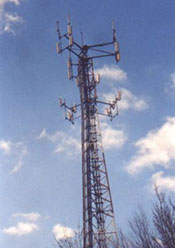Cellular Base Stations
Cellular Base Stations
As you drive along the highway, you may notice cellular towers or cellular base stations appearing every few miles. A base station is the interface between wireless phones and traditional wired phones. It’s what allows you to use your cell phone to call your home phone. The base station, a wireless system, uses microwave radio communication. It is composed of several antennas mounted on a tower and a building with electronics in it at the base. When you make a call on your cell phone, the cell phone and base station communicate back and forth by radio, and the radio waves they use are in the microwave region of the electromagnetic spectrum.
The base station antenna is mounted on tall towers because from this high point it is easier to stay in communication with cell phone users, who are often near the ground. The actual antenna elements of a base station are usually less than ten centimeters (about 4 inches), but may be grouped into clusters or “arrays” with heights of about a meter (about 3 feet). They need to be mounted on a tower to overcome obstacles, such as trees, hills, or tall buildings, that stand between the base station and your cell phone. You might see several racks of antennas at different heights along the tower. Each rack actually belongs to a different cellular or PCS service provider. Because the tower structure is so expensive, it is often economical for service providers to rent space on a tower that is owned by a competitor, or a third party. Most cells are divided into three sectors, and so each antenna rack will have a triangular shape. Each face of the rack will usually have three antennas installed.
Of the three antennas, two are for receiving and one is for transmitting. Two are used on the receive side so that the base station can compare signals and select the best antenna for each user within the cell. The transmitting antenna is usually placed between the two receiving antennas. Even though the receive frequency is different from the transmit frequency, the antennas are separated by several meters because of the large difference in power levels.
Under the tower is usually a small building that houses the electronics. To transmit calls, the base station requires a powerful transmitting amplifier to generate strong signals. This “power amplifier” is linked to the transmitting antenna by a length of cable. Connected by cable to the receiving antenna are low-noise amplifiers that can detect the weak incoming signal and separate it from any background noise that is present.
A bank of electronic circuits called the transceiver card rack connects to the low noise and power amplifiers, and converts their radio signals into digital signals, and vice versa. The transceiver is connected to the electronic switching device that routes calls between the base station and the main phone system. Elsewhere in the base station are supporting components such as the base station controller, which is like a computer that monitors and controls various functions so that a person does not have to be present to operate the station. An AC/DC rectifier system converts AC power supplied by the power company to DC power that is needed by the electronic circuits. Most base stations also have a backup DC power system that looks like a dozen or so car batteries connected together. If the AC power fails due to a blackout, the battery backup switches on to keep calls connected.
